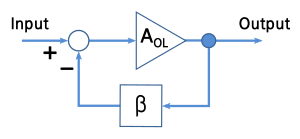
Back مضخمات ذات التغذية الخلفية السالبة Arabic Negativ tilbagekobling (elektronik) Danish Negative Rückkopplung German Realimentación negativa Spanish Contre réaction French Realimentación negativa Galician ह्रासक प्रतिपुष्टि प्रवर्धक Hindi Tegenkoppeling Dutch Negativ tilbakekobling NB Wzmacniacz ze sprzężeniem zwrotnym Polish

A negative-feedback amplifier (or feedback amplifier) is an electronic amplifier that subtracts a fraction of its output from its input, so that negative feedback opposes the original signal.[1] The applied negative feedback can improve its performance (gain stability, linearity, frequency response, step response) and reduces sensitivity to parameter variations due to manufacturing or environment. Because of these advantages, many amplifiers and control systems use negative feedback.[2]
An idealized negative-feedback amplifier as shown in the diagram is a system of three elements (see Figure 1):
- an amplifier with gain AOL,
- a feedback network β, which senses the output signal and possibly transforms it in some way (for example by attenuating or filtering it),
- a summing circuit that acts as a subtractor (the circle in the figure), which combines the input and the transformed output.
- ^ Santiram Kal (2004). Basic Electronics: Devices, Circuits, and IT fundamentals (Paperback ed.). Prentice-Hall of India Pvt Ltd. pp. 191 ff. ISBN 978-8120319523.
- ^ Kuo, Benjamin C. & Farid Golnaraghi (2003). Automatic control systems (Eighth ed.). NY: Wiley. p. 46. ISBN 0-471-13476-7.